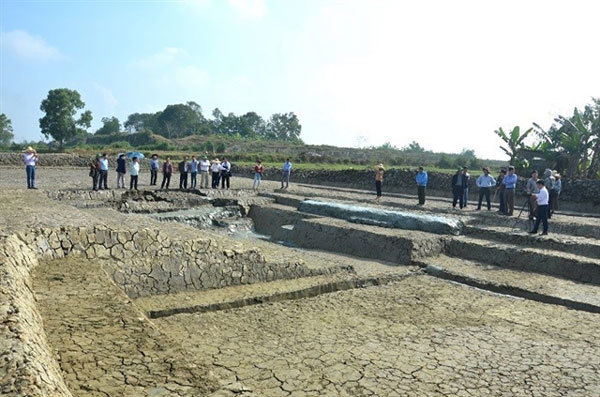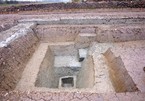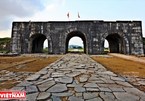 |
| Traces of the canal's banks made of clay, small stones, and laterite at the citadel. VNA/VNS Photo Hoa Mai |
The suggestions were made after a four-month excavation at the site, which started in last October.
Following a decision by the Ministry of Culture, Sports and Tourism, archaeologists from the Vietnam Archaeology Institute and the Ho Citadel Heritage Preservation Centre excavated the canal in the citadel.
They conducted research on a total area of 7,000sq.m and found traces of the canal banks, which included clay, laterite and architectural materials, utensils and tools.
They found various objects including small pebbles, fragments of bricks and tiles, copper coins, as well as pieces of ceramic from the Ly (1010-1225), Tran (1225-1400), Hồ (1400-1407), Le (1428-1527) and Nguyen (1802-1945) dynasties.
The archaeologists provided information on the overall structure of the citadel, which revealed the existence of a stone workshop at the site.
They stressed the need to restore the canal surrounding the citadel to recreate the original environment, culture and history of the site to further attract visitors.
The excavation will last until April this year.
Based on results of this excavation and previous ones in 2015 and 2016, the researchers have uncovered the form, function and role of the canal.
This is the first time historians be able to confirm the canal is an important part of the citadel. It measures 50-60m in width and 6.8-7.2m in depth, however the length is yet to be established.
Ho Citadel, also known as Tay Do, Tay Giai or An Ton Citadel, is a special structure made of stone, which is located in the communes of Vinh Tien and Vinh Long, in the Vinh Lo District of Thanh Hoa Province.
It was first built by Ho Quy Ly (1336-1407) at the end of 14th century and served as the capital of Dai Viet under the Tran dynasty (1389-1400) and the capital of Dai Ngu under the Ho dynasty (1400-1407).
The dimensions of the citadel are 870m by 883m.
According to experts, it is the only citadel in the country built entirely of stone that has remained nearly intact throughout the nation’s history. The structure is an outstanding example of a new style of construction for a Southeast Asian imperial city.
It was recognised as a World Cultural Heritage site by UNESCO in 2011. VNS

Moat corner structure found in Ho ancient citadel
Archeologists said they have uncovered the structure of a moat corner and a part of the citadel foundation in the west of the over 600-year-old royal Ho citadel in Thanh Hoa province.

Thanh Hoa to celebrate 990th naming anniversary
Lam Son Square in the north central province of Thanh Hoa will be turned into a kaleidoscopic stage for a grand ceremony to mark the 990th anniversary of the locality’s naming on May 8.
 Archaeologists have suggested authorities restore a canal system in Ho Citadel in the central province of Thanh Hoa.
Archaeologists have suggested authorities restore a canal system in Ho Citadel in the central province of Thanh Hoa.